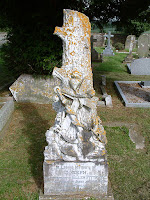 |
| Hughson Family Cemetery, Amaranth, Dufferin, Ontario |
Abraham was the son of James Hughson (1746-1806) and Anne Carr (1743-1830) of the Province of New York. During the American Revolution, James remained loyal to the British Crown. According to his 1795 New Brunswick Land Petition, he abandoned his home in Albany in 1776 and sought the protection of the British Army in New York City. He stated in his petition that he had served a year and an half under Thomas Ward1 in the construction of Fort DeLancey at Bergen Neck.
In 1783 the British commander, Sir Guy Carlton, received orders to withdraw from New York City. 29,000 Loyalist refugees were evacuated by ship. Many refugee families, including James and his family, were brought to the St John River valley in what is now New Brunswick. James settled his family on Belleisle Bay, a fjord-like branch of the Saint John River.
 |
| Abraham Hughson 1771-1862 |
Based on the information in his father's petition, it seems unlikely that Abraham was born in Brooklyn. James had been born in Dutchess County, New York and had married Ann there in 1766. It is unclear when he moved to Albany.
Abraham is thought to have married Tamar Kelly (1776-1861) in New Brunswick about 1798. In his 1824 petition, Abraham states that he has six boys and two girls. It has been suggested that there were at least two more children who presumably died before 1824. Most online sources claim that the four oldest children were born in New Brunswick, while the youngest were born in Upper Canada. Isaac Newton Hughson (1808-1897), George Leonard Hughson (1811- ?), and Hannah Hughson (1813-1881), however, consistently stated in census records that they were born in the United States.
 |
| Upper Canada Land Petition |
Abraham is thought to have settled on Lot 3 Concession 1 in Amaranth Township in 1823 but may have been living there as early as 1819.
In the 1820s Amaranth Township was a "howling wilderness." According to family tradition it took Abraham, his son Thomas, and a team of oxen, fourteen days to travel from Niagara. It would take another eight years before more settlers arrived.
For most of the 20th century, the Hughson family cemetery was abandoned and forgotten. In 1991 six stones were located, stacked against a fencepost. The gravestones were removed from the site, and placed into storage. In 2001 the gravestones were returned and placed into a concrete cairn.
1Captain Thomas Ward (later Major) commanded the Loyal Refugee Volunteers. Formed in November 1779, the unit was tasked with cutting firewood on Bergen Neck in New Jersey for the British garrison of New York, and to make minor raids into rebel territory. It is interesting to note that the Loyal Refugee Volunteers included some Black Loyalists. Fort DeLancey was a blockhouse on Bergen Neck built after the battles at Fort Lee in 1781. The Loyal Refugee Volunteers withdrew from Bergen Neck in October 1782. Thomas Ward went on to become one of the first Loyalist settlers in Nova Scotia.










































